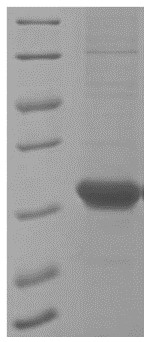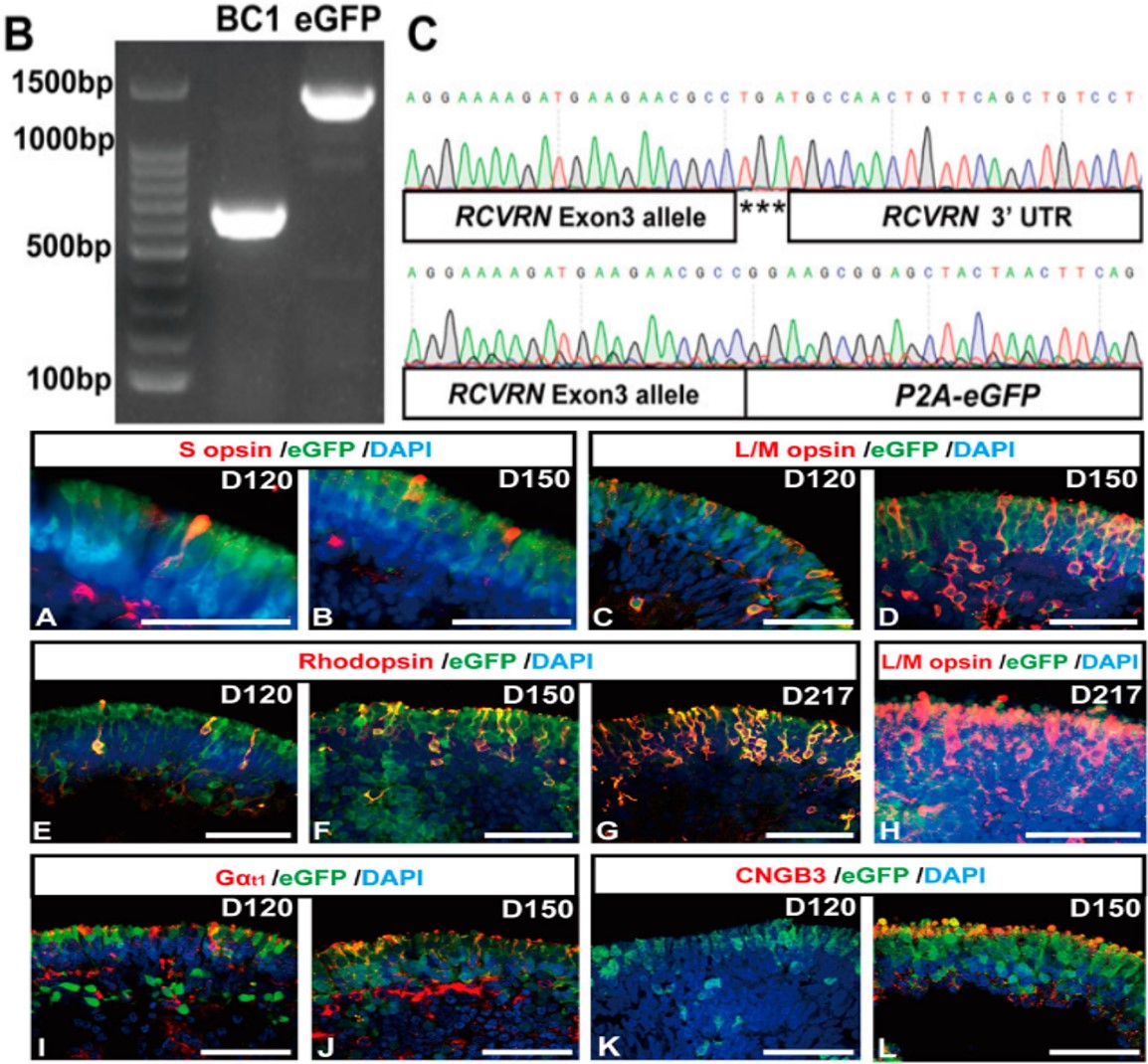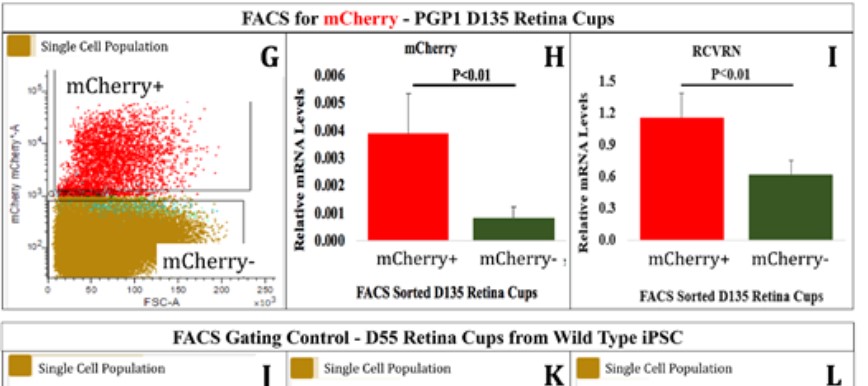RCVRN
-
Official Full Name
recoverin
-
Overview
This gene encodes a member of the recoverin family of neuronal calcium sensors. The encoded protein contains three;calcium-binding EF-hand domains and may prolong the termination of the phototransduction cascade in the retina by;blocking the phosphorylation of photo-activated rhodopsin. Recoverin may be the antigen responsible for;cancer-associated retinopathy. -
Synonyms
RCVRN; recoverin; RCV1; cancer associated retinopathy antigen; cancer-associated retinopathy protein;
- Recombinant Proteins
- Cell & Tissue Lysates
- Protein Pre-coupled Magnetic Beads
- Human
- Mouse
- Rhesus Macaque
- E.coli
- HEK293
- HEK293T
- Insect Cell
- Mammalian Cell
- Mammalian cells
- Wheat Germ
- Yeast
- Flag
- GST
- His
- His (Fc)
- Avi
- Myc
- His|Myc
- DDK
- N/A
- Background
- Quality Guarantee
- Case Study
- Involved Pathway
- Protein Function
- Interacting Protein
- RCVRN Related Articles
What is RCVRN protein?
RCVRN, also known as recoverin, is a protein that is predominantly expressed in retinal photoreceptor cells. It is a calcium-binding protein that plays a crucial role in the regulation of vision signaling in the retina. RCVRN interacts with other proteins in the photoreceptor cells to modulate the sensitivity of the visual response to changes in light intensity. It has been shown to regulate the activity of rhodopsin, the light-sensitive protein in rod cells, and may play a role in the adaptation of photoreceptors to different lighting conditions. RCVRN mutations or dysfunction have been associated with certain retinal diseases, including retinitis pigmentosa and cone-rod dystrophy.
What is the function of RCVRN protein?
The main function of RCVRN is to regulate the activity of rhodopsin kinase, an enzyme involved in the visual signaling pathway. RCVRN interacts with rhodopsin kinase and inhibits its activity in the absence of light. When light is detected by photoreceptor cells in the retina, calcium ion levels increase, leading to the dissociation of RCVRN from rhodopsin kinase and the subsequent activation of the kinase. This activation allows for the efficient phosphorylation and desensitization of activated rhodopsin, thus allowing the photoreceptor cells to adapt to varying light conditions. The precise role of RCVRN in tuning the sensitivity of photoreceptor cells to light stimuli helps maintain visual function and homeostasis in the retina.
RCVRN related signaling pathway
The signaling pathway involving RCVRN protein is still not fully understood. However, it is known that RCVRN interacts with other proteins involved in the visual transduction cascade, such as rhodopsin kinase (GRK1) and cyclic nucleotide-gated ion channels (CNGCs). RCVRN may modulate the activity of these proteins to regulate the response of photoreceptor cells to light stimulation.
The precise signaling pathway and mechanisms mediated by RCVRN are still an active area of research in the field of vision and retinal biology. Further studies are needed to unravel the complete signaling cascade involving RCVRN and its functional implications in visual processes.
RCVRN Related Diseases
Mutations or dysfunctions in the RCVRN protein can lead to various retinal diseases, including autosomal dominant retinitis pigmentosa (ADRP), a group of inherited retinal degenerative disorders characterized by progressive loss of photoreceptor cells in the retina. In ADRP, mutations in the RCVRN gene disrupt the normal function of the protein, resulting in abnormal regulation of rhodopsin kinase activity and impairing the process of visual signal transduction.
Additionally, dysregulation or abnormal expression of RCVRN has also been associated with other retinal disorders, such as cone-rod dystrophy and autoimmune retinopathy. Further research is ongoing to better understand the role of RCVRN and its involvement in these diseases. This knowledge may contribute to the development of potential therapeutic approaches for the treatment and management of retinal diseases.
Biomedical Application of RCVRN Protein
In terms of biomedical applications, RCVRN has been used as a biomarker for the diagnosis and prognosis of retinal diseases. It can be detected in ocular fluids and tissues, and its altered levels or expression patterns can provide valuable insights into the progression and severity of retinal degeneration. Additionally, studies have focused on developing therapeutic strategies targeting RCVRN to restore its normal function or compensate for its loss in retinal diseases. However, further research is needed to fully understand the therapeutic potential and feasibility of targeting RCVRN in the clinical setting.
High Purity

Fig1. SDS-PAGE (Cat. No.: RCVRN-2765H)

(Yuanyuan Guan, 2022)
Fig2. RCVRN-eGFP labels both mature cones and rods in late-stage retinal organoids. (A–L) Immunofluorescence images showed the expression of blue cone marker S opsin, red/green cone marker L/M opsin, rod marker Rhodopsin, α-subunit of rod transducin (Gαt1), and cone-specific phototransduction protein CNGB3 in eGFP+ cells in late-stage retinal organoids older than D120.

(Phuong T. Lam, 2020)
Fig3. Confirmation of PGP1-derived retinal organoids corresponded to the appropriately targeted cell types. At D55 (A–F, J–L) and D135 (G–I), the retinal organoids were dissociated into single cells and used for FACS analysis. At D55, (A) the Cerulean+ population was sorted from the Cerulean− population.
RCVRN involved in several pathways and played different roles in them. We selected most pathways RCVRN participated on our site, such as Phototransduction, which may be useful for your reference. Also, other proteins which involved in the same pathway with RCVRN were listed below. Creative BioMart supplied nearly all the proteins listed, you can search them on our site.
| Pathway Name | Pathway Related Protein |
|---|---|
| Phototransduction | GNGT1;CALM3A;SLC24A1;GC3;CALM3B;SAG;CALM2A;RLN1;GNB4B |
RCVRN has several biochemical functions, for example, calcium ion binding, calcium sensitive guanylate cyclase activator activity. Some of the functions are cooperated with other proteins, some of the functions could acted by RCVRN itself. We selected most functions RCVRN had, and list some proteins which have the same functions with RCVRN. You can find most of the proteins on our site.
| Function | Related Protein |
|---|---|
| calcium ion binding | PCDH2AB1;THBS3;BRAF;SYT5;CBLB;LTBP3;JAG1B;TPO;PCDHB11 |
| calcium sensitive guanylate cyclase activator activity | GUCA1E;RCVRN;GUCA1G;GUCA1B;GUCA1A;GUCA1C;GUCA1D;GUCA2B |
RCVRN has direct interactions with proteins and molecules. Those interactions were detected by several methods such as yeast two hybrid, co-IP, pull-down and so on. We selected proteins and molecules interacted with RCVRN here. Most of them are supplied by our site. Hope this information will be useful for your research of RCVRN.
PQBP1; TGFBR2; SMAD3; IL15RA; GIT2
- Q&As
- Reviews
Q&As (5)
Ask a questionIndividuals with genetic mutations affecting RCVRN and those with early-stage retinal diseases may potentially benefit more from targeted therapies.
The expression of RCVRN may change with age, and understanding these changes can provide insights into age-related vision disorders.
Changes in RCVRN expression levels may correlate with the progression of retinal disorders, serving as a potential indicator of disease severity.
Some clinical trials are investigating the safety and efficacy of gene therapies targeting the RCVRN gene for treating specific eye conditions.
Modulating RCVRN expression could potentially restore or enhance photoreceptor function, providing therapeutic benefits for vision-impaired individuals.
Customer Reviews (3)
Write a reviewWhether investigating metabolic pathways, studying enzymatic activity, or exploring drug targets, this protein offers versatility and reliability, allowing for accurate and meaningful data collection.
In addition to the remarkable protein quality, the manufacturer provides excellent technical support, proving to be a valuable resource when troubleshooting experimental challenges.
Incorporating this protein into scientific investigations undoubtedly enhances the reliability and effectiveness of research endeavors.
Ask a Question for All RCVRN Products
Required fields are marked with *
My Review for All RCVRN Products
Required fields are marked with *


